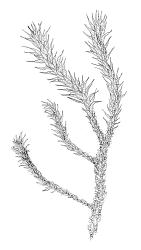Plants medium-sized to rather large, bright-, yellow-, or brown-green, mostly lustrous when dry, forming interwoven mats in damp habitats. Stems either creeping or ascendant, irregularly branched, in cross-section with 2–5 layers of small, incrassate cortical cells and a small central strand; rhizoids very sparse, smooth. Stem leaves erect- to widely-spreading, sometimes moderately secund, crowded, ovate-cordate or triangular-cordate, gradually or abruptly narrowed to a channelled acumen, striolate when dry, sometimes ± sheathing or weakly decurrent at base, entire or nearly so; mid laminal cells vermicular, mostly blunt at ends, incrassate and weakly to distinctly porose, smooth or very weakly projecting at ends, becoming shorter and strongly porose at leaf base; alar cells variable, often subquadrate and incrassate, in some species inflated and thin-walled, often orange or brown. Costa usually single and elongate, sometimes short and double or lacking. Branch leaves narrower and usually ± shorter. Axillary hairs not seen in N.Z. material. Pseudoparaphyllia foliose, polymorphic. Paraphyllia absent.
Autoicous, dioicous, or polygamous. Inner perichaetial leaves erect, narrowly acuminate from an oblong-lanceolate base, costate (not seen in C. stellatum). Setae elongate, smooth; capsules strongly curved and asymmetric, subcylindric; peristome hypnoid, as per family. Calyptra cucullate, smooth. Spores finely papillose.
Campyliadelphus is a small genus distributed predominantly in temperate and cool parts of the northern hemisphere. The generic concept advocated by Kanda (1976) is adopted here. Accordingly, Campyliadelphus species are distinguished from species of Campylium by being larger plants with entire rather than serrulate leaf margins, appendiculate rather than nodose endostomal cilia, and predominantly foliose (vs filamentous or foliose) pseudoparaphyllia.
Campyliadelphus stellatus and C. polygamus were treated as species of Campylium by Brotherus (1925, p. 336) and Crum & Anderson (1981). C. polygamus was likewise treated as a Campylium by Sainsbury (1955) who inexplicably failed to discuss C. stellatus. Hedenäs (2003) retained Campyliadelphus stellatus in Campylium and placed C. polygamus in Drepanocladus.
| 1 | Costa inconspicuous and variable, either absent, or very weak and single or double; stem leaves mostly >0.8 mm wide (not flattened); mid laminal cells mostly porose, the cell walls ± equal the lumina in width; alar cells forming a large ± auriculate group extending c. ¼ the leaf width; dioicous | C. stellatus |
| 1' | Costa single, extending to mid leaf or beyond; stem leaves <0.8 mm wide (not flattened); mid laminal cells not or scarcely porose, the cell walls much narrower than the lumina; alar cells forming a large roughly triangular group extending nearly to costa base; autoicous | C. polygamus |
| Category | Number |
|---|---|
| Indigenous (Non-endemic) | 2 |
| Total | 2 |




